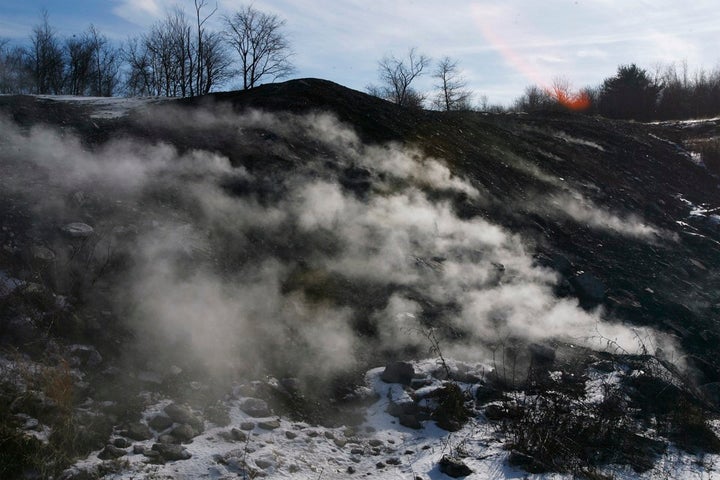
By Sarah Zhang
The fire under Centralia has been burning since 1962. That spring, a dump in the Pennsylvania mining town caught on fire. The dump was in a strip mine, which led to an underground mine, which led to a coal seam under the town. Fire met fuel, miles and miles of fuel, so much fuel that firefighters have long since given up on extinguishing the fire.
The town of Centralia is pretty much empty now. It’s too dangerous: The ground is unstable, and sulfurous steam vents up from the underground fire. The post office discontinued Centralia’s zip code in 2002. These days, the town is a curiosity for roadtrippers — and a field site for scientists like Ashley Shade, a microbiologist at Michigan State University.
Shade studies how microbes evolve, in particular what happens when their homes are destroyed. When the fire started burning in Centralia, the once cool ground turned into unbearably hot dirt. Shade has recorded soil as hot as 120 degrees Fahrenheit near steam vents. “The soil remains hot for years, or multiple generations for microbes,” says Shade. As the fire depleted the coal seam underneath, the fire front moved, and some areas of the ground cooled down again.
When Shade and her lab made the trip down to Centralia two years ago, they made sure to sample soil on top of active fire fronts and former fronts. They took eight-inch-long PVC pipes, drove them into the ground with sledgehammers, and pulled up soil cores to take back to the lab. Then they sequenced the soil, taking a genetic snapshot of what microbes lived in the ground, which they share in a paper uploaded, though not yet peer-reviewed, to the preprint server PeerJ.
The types of microbes living in hot versus once-hot-now-cooled soil were, unsurprisingly, very different. What did surprise Shade is how quickly the microbial community in the recovered soil went back to looking like what it was pre-fire. This is good news; it means microbial communities are resilient in the face of massive upheaval. In the charred aftermath of a forest fire — to make a more macro analogy — lichens come first, then grasses, then shrubs, and then finally trees. But before that can happen, the same ecological succession plays out in miniature with the millions of microbes that live in soil.
What still puzzles Shade, though, is where those different microbes in hot soil came from. She hypothesizes the soil has a microbial “seed bank”—thermophiles aka hot-loving bacteria, for example, laying dormant for years as spores, just waiting for the off chance it’ll get hot. Soil may not look like much, but it is teeming with microbes with extraordinary abilities.
“Soil may not look like much, but it is teeming with microbes with extraordinary abilities.”
This seed-bank hypothesis makes sense for Peter Hartel, a soil microbiology and professor emeritus at the University of Georgia. He cites an example in that happens in a small scale in our own backyards: the compost pile. As banana peels and eggshells rot, they give off heat. And as it gets hot, the thermophiles take over, breaking down molecules that cool-loving bacteria cannot — which is why small compost piles that cannot retain heat are not as effective. Ordinary soil, says Hartel, “is just loaded with all these thermophilic organisms, which should have no business in it.” They’re just waiting their turn.
The blossoming of thermophilic organisms in coal-mine fires, which stay hot for much longer than a compost pile, could mean that such fires are fertile hunting grounds for rare microbes. A colleague of Shade’s at Michigan State has visited Centralia to look for a bacteria that fixes nitrogen, which could cut the use of nitrogen fertilizer in agriculture.
And others, like Madan Kharel, a biochemist now at the University of Maryland Eastern Shore, have gone to a different coal-mine fire in Kentucky to look for antibiotics and anti-cancer drugs. Lots of antibiotics originally come from bacteria, and big pharma companies have already gone digging through ordinary soil bacteria. “Our logic is what’s overlooked are those unique extreme environments,” says Kharel. His colleagues at the University of Kentucky, where the Ruth Mullins coal-mine fire work began, are now working on antibiotics isolated from bacteria at the site
Coal-mine fires are man-made disasters, long-lasting reminders of mining’s environmental destructiveness. How ironic then, if they could one day lead to a life-saving drug.
This story originally appeared on TheAtlantic.com.
More from The Atlantic: Flat-Earthers Have a Wild New Theory About Forests, Fear of a Female President
